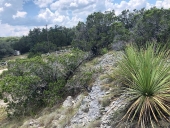










 3
3








Travis Johnson wrote:There are two types of springs, and you have described the first type that is concentrated by nature, and comes up in one spot. For the kind that you have, which is spread out, you simply gather the water into a concentrated area for it instead.
To do that takes inexpensive drain tile, which is a misnomer because it is actually just perforated plastic pipe,, about 4" in diameter, and costs $55 for 100 feet where I live.
What you want to do, is get enough pipe to branch out in a Y shape, or multiple y shapes like branches off a tree, and concentrate all that water to a central point that is down hill by at least 1/4 inch per foot of linear travel. That will gather up as much water from the wet area and concentrate that water to a single point. Here, you dig a hole as deep as you can go/want, lining it with well casing. This is 4 feet in diameter, concrete tiles. You want to bring your drain tile so that it terminates inside these tiles by drilling a hole through the side of one of them. Then at the bottom of the drain tile, put in several inches of screened gravel so that as the water runs in, it will be in a clean environment.
From there you can buy a manway cover that goes on top of the well casing, or build a wooden well cover like they did back in the old days. If the well is deeper than 4 feet, I would go with a cement cover only for liability purposes as wood structures rot leaving wells open to be walked into by kids and those unaware.




Myrth
https://ello.co/myrthcowgirl
 5
5




"Where will you drive your own picket stake? Where will you choose to make your stand? Give me a threshold, a specific point at which you will finally stop running, at which you will finally fight back." (Derrick Jensen)
 2
2




 1
1




 this image illustrates the principle of how they form in my area. I was able to attain a soil map showing where the different types of soil intersect
this image illustrates the principle of how they form in my area. I was able to attain a soil map showing where the different types of soil intersect  Here is a synopsis of the three soils on my property in order of steep to flat.
Here is a synopsis of the three soils on my property in order of steep to flat.








John Daley Bendigo, Australia The Enemy of progress is the hope of a perfect plan
Benefits of rainfall collection https://permies.com/t/88043/benefits-rainfall-collection
GOOD DEBT/ BAD DEBT https://permies.com/t/179218/mortgages-good-debt-bad-debt

|
Screaming fools! It's nothing more than a tiny ad:
Learn Permaculture through a little hard work
https://wheaton-labs.com/bootcamp
|





